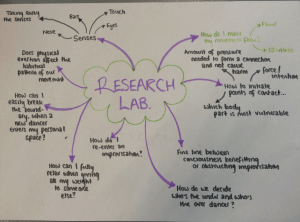…. off the floor, awareness, disorientation and letting go.
We started this session off again by looking at the assigned readings and sharing our ideas and thoughts with the rest of the class. Firstly we talked about Sensing Weight In Movement by Suzanne Ravn. We discussed how this reading focused on different types of dancers and how they centred their weight differently depending on their techniques. I found this interesting to read because I had never really stopped and thought how dancers use of gravity differs so greatly demanding on their style of dance. For example for ballet dancers ‘For the four ballet dancers a sense of vertical balance is central to their control of their weighted mass’ (Ravn, 2010, 23) this quote relates to my own practise as I have been bought up with a very heavily ballet background which is why I struggle to sometimes let go of my posture and weight when improvising. The article then goes on to describe the use of gravity within contemporary dancers which is ‘giving up control of movement to let the body be connected to gravity’ (Ravn, 2010, 24) This quote was interesting as this is my objective within my own practise to become more able to completely drop my weight and let go.
The next reading was Is contact a small dance? By Byron Brown. The one quote that stood out for me the most within this reading was ‘ongoing process of awareness and responsiveness which requires no thought’ (Brown, 1980, 74) I again picked this quote above others because I believe this relates again to my own practise. By having no intention and trying to not think about my movements before performing them is constantly an obstacle I am always facing within contact improvisation. The thought of moving without choreographed moves frightened me at the start of this module. However through the weeks have progressed I feel like I have got better at just going with the flow and letting my internal self make spontaneous decisions with out thought.
We started of the practical side of the session by standing in a space with our eyes closed. The aim was to focus on our body and what it was doing when we were focusing on keeping our body as still as possible. We then started to shift our weight forwards and backwards and experimented with how far we could shift our weight however still balancing. This exercise then relates back to the reading of sensing weight in movement. This made me aware of where my weight was and how interesting it was to see how far you could shift your weight with out stepping of it.
We then went onto a group exercise which involved a lot of trust amongst the group. I believe my year group are all very close and we get on so well together so group activities never make me nervous. This involved someone moving into the middle of the space and saying 3,2,1 and then a group of people would guide you to the floor by placing you slowly down. Even though I completely trust all the people in my class and know they wouldn’t drop me I still found this exercise really difficult. This was because I didn’t give them all my weight which caused my body to tense up. I will have to learn how to relax my body in these situations so it will look more smoother.
Lastly we tried some lifting work. I found this fun and exciting, as it was something we had never tried at university before. We were split into two groups and tried a lift where we simply lifted one person horizontal lying down above our heads. This lift worked successfully as we worked as a team and distributed the weight evenly amongst ourselves. I even had a go at being the person in the air, which was an experience as I am taller and heavier than most other girls so I am traditionally a lifter instead. I found it easy to be lifted, as I wasn’t nervous and found it a exciting sensation by giving all my weight to my friends and them being able to take the weight at ease.
This week we also started our research lab. This involved picking questions the group has on contact improvisation and then pick two to focus one. My group picked the questions, ‘how much would the experience of contact improvisation change if you took away one of these senses? (hearing, vision, touch or smell) secondly ‘How to initiate points of contact?’. Im looking forward to exploring these questions in more depth with my group and then see what the outcomes are to these questions.
This lesson really made me aware of my sense of gravity and how I need to keep being aware that my objective is to try and let people take my weight and to let go of it myself.
(Research lab poster)
Brown, B. (1997) Is Contact a Small Dance? Contact Quarterly: Contact Improvisation Sourcebook, 1(6) 72-75.
Ravn, S. (2010) Sensing Weight in Movement. Journal of Dance and Somatic Practices, 2(1) 21-34.
